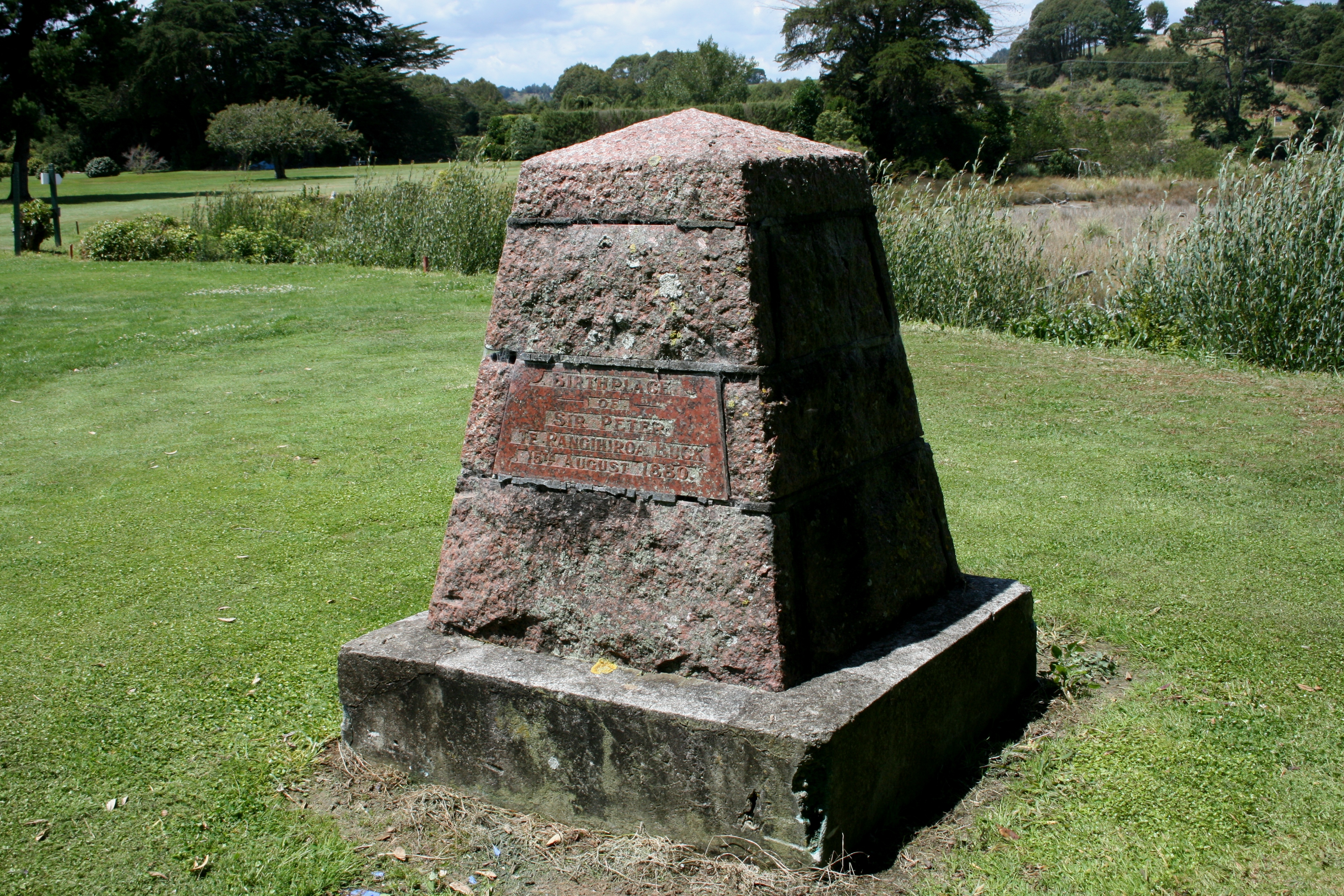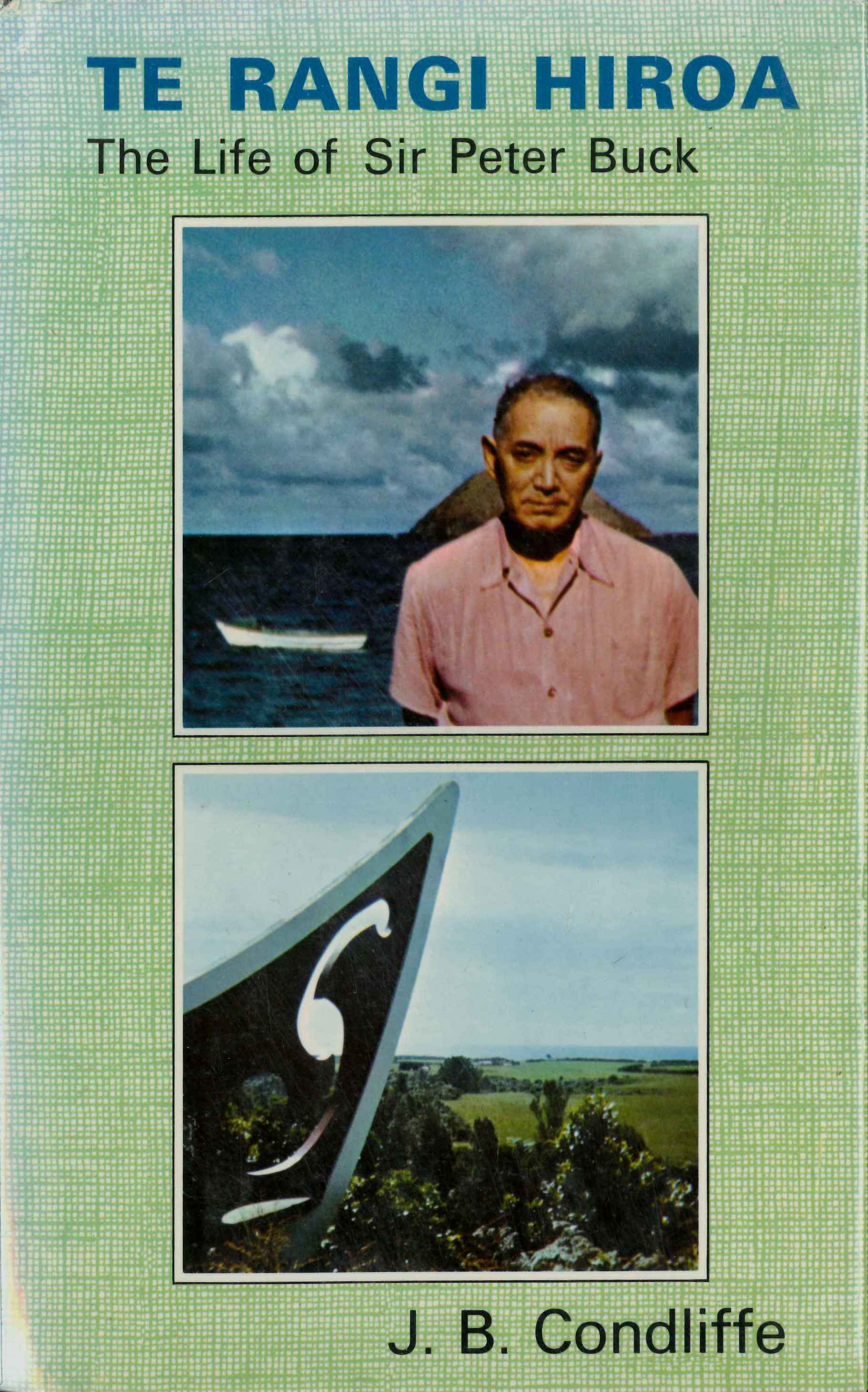



The birthplace of Te Rangi Hīroa (Sir Peter Buck) was marked with a monument on 15 August 1953. The monument is situated near the number 2 hole on the Urenui Golf Course and was unveiled by the Minister of Māori Affairs, Hon E B Corbett.
Plaque text reads:
BIRTHPLACE
OF
SIR PETER
TE RANGIHIROA BUCK
15 AUGUST 1880
THE URENUI KNIGHT : TE RANGI HIROA
If the depiction on cereal cards can be taken as a indication of New Zealand renown, then Te Rangi Hīroa, with at least three between 1942 and 1972, as well as a 1990 postage stamp, must surely be one of the most famed of Kiwis.
Thrusting seaward from the grey-green bush-clad slopes of Okoki pa , north of Urenui township, is the red and white concrete canoe prow marking the resting place of one of Taranaki's most famous sons, Te Rangi Hiroa (Sir Peter Henry Buck) and his wife Margaret.
A kilometre or so to the northwest, among the neatly manicured greens of the Urenui Golf Club, is the granite-mounted plaque marking the opposite end of Peter Buck's life - his birth at the kainga (village) of Maruwehi about 1877.
The son of Irish/English fortune seeker, William Buck, and Rina of North Taranaki's Ngati Mutunga iwi (tribe), the young Peter was brought up by his stepmother, Ngarongo and her mother, Kapuakore. Growing up only a few short years after the destruction and land alienation of the Taranaki wars, Peter was well schooled through a n expanding Government education system.
Buck was granted entrance to the prestigious Hawkes Bay Maori college, Te Aute, in 1896. That generation of Te Aute scholars was to shake the foundations of New Zealand society - Apirana Ngata, Māui Pomare and Te Rangi Hīroa - a trio who publicly resurrected what was then supposed to be a "dying race"
Buck's three years at Te Aute ended with the gaining of a medical preliminary and a prominence in sport, including cricket 1st XI and athletics captaincies.
By 1904, he had graduated from Otago medical school and a few years later gained an M.D. with a thesis on Maori health.
His partner for life, Margaret Wilson, who he married in 1905, was also of Irish descent. She became the driving force behind the easy-going academic who forsook the ' Varsity cloisters and established himself as a practising doctor among the Maori communities of the North Island. A brief political career as the M.P. for Northern Maori between 1909 and 1914 witnessed the usual Buck ability to gain illustrious positions with his entrance to Cabinet in 1912.
On the outbreak of the First World War, Buck headed to the Middle East with a Maori volunteer contingent as medical officer. It was during the conflict that he seriously began his anthropological studies and, incidentally first met fellow expatriate, economist, J. B. Condliffe. They were to become firm friends; two Kiwis whose paths crossed in Hawaii and at Yale, and Jack Condliffe was, in 1971, to publish a biography of his old friend and collegue. Anthropological studies increasingly began to dominate Buck's attention during the 1920s. Several of his early publications, now classics in ethnography, were published by the New Plymouth-based, Polynesian Society with its local doyens, W. H. Skinner, S. Percy Smith and Percy White.
Peter's most fervent dreams were realized with his appointment, in 1927, as ethnologist at the prestigious Bishop Museum in Hawaii, followed by a professorship at Yale University in the United States and then the pinnacle, the directorship of the Bishop in 1936. In these hallowed halls, his forté for Polynesian history and tradition was nurtured well and found its final full flowering. A constant stream of erudite scientific articles, still highly regarded, appeared from his pens, as one of the first Polynesians to look at themselves, he forged new fields in Pacific history.
It was to be his incomparable 1938 book, Vikings of the Sunrise, that established Peter Buck as a popular author and swiftly raised him from respected academician to near- cult popularity. Here, indeed, was the local lad from Urenui who made good and could foot it well and fast with the most distinguished historians the world could provide. Cereal card fame had arrived! - a fame that was finally and securely cemented in his homeland by the New Zealand publication of "Vikings" in 1954 after a hiatus of 16 years created by the Second World War
A stream, too, of awards and honours followed; Doctors of Science from several universities; U.S., Swedish, New Zealand and British fellowships and honours culminated in his receipt of a K.C.M.G. in the King's Birthday honours in 1946.
A year later an operation for cancer heralded the beginning of his valiant but ultimately unsuccessful battle with the disease.
His final and tearfully fond farewells were conveyed to his marae at Urenui and the house of his childhood, Mahi Tamariki, in March of 1949. Working to the end, Te Rangi Hīroa, Sir Peter Buck collapsed and soon after died in his second home, Hawaii, on December 1st 1951.
Two years later, a Taranakian from Okato, the Hon. E. B. Corbett, Minister of Maori Affairs, conveyed the ashes of this most illustrious son of Taranaki to his final resting place among the titoki trees of Okoki.
Ron Lambert
Further Reading

Condliffe, J. B.: Te Rangi Hiroa - The Life of Sir Peter Buck, 1971
Please do not reproduce these images without permission from Puke Ariki.
Contact us for more information or you can order images online here.